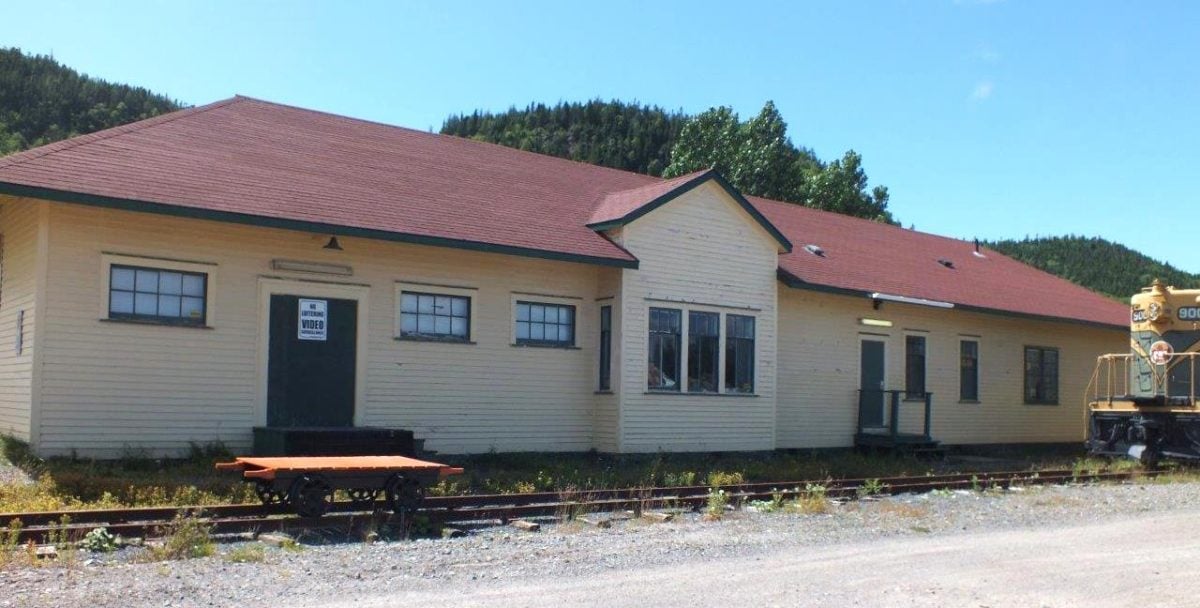The Clarenville Railway Station is a rectangular, single-storey, wooden, hip-roofed building with large eaves and a verandah. It is located at 7 Stanley Cresent, off Marine Drive in Clarenville, NL. The municipal heritage designation is confined to the footprint of the building.
Formal Recognition Type
Municipal Heritage Building, Structure or Land
Heritage Value
The Clarenville Railway Station has been designated a municipal heritage site by the Town of Clarenville due to its historic, cultural, social and aesthetic values.
The Clarenville Railway Station has historic value because it survives from a period in Newfoundland history when rail was a primary means of transportation, before the Trans-Canada Highway was completed in the mid-1960s. The railway station at Clarenville was constructed in 1891, the first of five service centres in Newfoundland at the time, with a roundhouse and service buildings. The current station building was constructed in 1942 and is one of few buildings directly related to the railway remaining in the town.
Clarenville Railway Station has further historic and cultural value because the establishment of the railway was a turning point in the community’s growth into a regional hub of commercial activity and transportation at the base of the Bonavista Peninsula. The five small communities that amalgamated to form Clarenville were initially based around lumbering and farming, but Clarenville grew into a service community upon the construction of a railway station. The Bonavista Branch Line later connected to the main line at Clarenville. Clarenville Railway Station was a major employer until its closure in 1988. Other businesses and services also developed along with the station to serve the larger population and travelers. The station was also crucial in the establishment of other major ventures in Clarenville, including the Colas plant (an emulsified asphalt product) and the Clarenville Shipyard, which also relied on it to transport goods.
The Clarenville Railway Station has social significance because of the various roles it has played in community life. In addition to its railway function, it also once housed the local telegraph office and customs office. The Clarenville Shrine Club took ownership of the building in 1996, later sharing it with the local Masons, Clarenville Masonic Lodge No. 23. As the Clarenville Shrine-Masonic Centre, the building is purportedly the first headquarters building shared by Shriners and Masons in North America.
Clarenville Railway Station has aesthetic value as an example of a period railway station building in Newfoundland. Its basic rectangular, single-storey, wooden-frame design, including its hipped roof with large overhanging eave, is fairly typical of its kind. The protruding, gable-capped central sections at the front and back are more unusual, and lend architectural interest. The building retains most of its original style multi-paned, wooden windows, and is clad in typical painted clapboard, with wooden trims and cornerboards. The verandah-style overhang covering the entrance on the east end of the rear of the building once provided shelter for waiting passengers, and so is a telltale sign of the building’s original function. Altogether, the building remains a defining, landmark structure at the historic centre of Clarenville.
Source: Town of Clarenville Town Council meeting minutes of 2007/02/20
Character Defining Elements
All those exterior elements that are indicative of the age and original function of the building, and that contribute to its design aesthetic, including:
– location in the historic centre of Clarenville;
– rectangular building plan;
– single storey construction;
– roof pitch and ridge lines;
– projection and style of eaves;
– narrow, painted clapboard, corner boards, eaves and trims;
– dimensions, location, materials and design of verandah;
– and style and placement of original exterior windows and doors, including trims.




